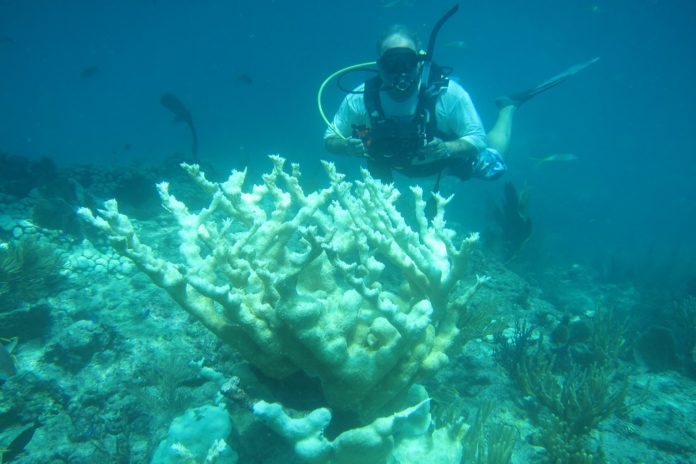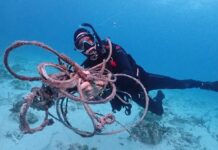
Environmental stressors like warming water temperatures are contributing to massive coral death, scientists say. But a recent study with three decades of data collected from Looe Key Reef is revealing another serious problem — land-based nutrient runoff.
Looe Key Sanctuary Preservation Area is about 5.5 nautical miles south of Ramrod Key, about 8 nautical miles southwest of Bahia Honda State Park.
Data within the study, published in the international journal Marine Biology, shows living coral cover at Looe Key Sanctuary Preservation Area went from nearly 33 percent in 1984 to less than 6 percent in 2008. And while the annual rate of coral loss varied during the study, it increased between 1985-87 and 1996-99 following periods of heavy rainfall and increased water deliveries from the Everglades.
Between 1991-95, the study shows significant increases in Everglades runoff and heavy rainfall resulted in increases of reactive nitrogen, which cause biodiversity loss, at Looe Key. Phytoplankton levels for offshore reefs are also high as evidenced by the presence of macroalgae and harmful algal blooms due to excessive nutrients. The issue? Nutrient-enriched runoff, from improperly treated sewage and fertilizers to topsoil, are increasing nitrogen levels. That’s causing phosphorus starvation in the corals and reducing their temperature threshold for bleaching.
“Our results provide compelling evidence that nitrogen loading from the Florida Keys and greater Everglades ecosystem caused by humans, rather than warming temperatures, is the primary driver of coral reef degradation at Looe Key Sanctuary Preservation Area during our long-term study,” said Brian Lapointe, senior author and a research professor at FAU’s Harbor Branch.
According to the study, nitrogen loading to the coast is predicted to increase by 19 percent globally from changes in rainfall due to climate change. Management actions are urgent and needed to prevent further degradation, and Lapointe said there are initiatives people can take about the nitrogen problem such as reducing fertilizer inputs, and at a larger level, increasing storage and treatment of storm water on the Florida mainland.
Andy Bruckner, Florida Keys National Marine Sanctuary research coordinator, said the study highlights the role nutrients play in the health of Florida’s reefs. However, he said it’s important to note that nutrients aren’t the only factor responsible for the decline. Climate change is also posing significant stress on reefs worldwide.
“The major losses of coral to the sanctuary reefs is due to bleaching and disease, and both of these threats have occurred throughout the region in both areas affected by nutrient inputs as well as remote locations with no nutrient impacts,” he said. “We know elevated nitrogen can affect the symbiosis corals have with algae, and it can result in bleaching, but the recent large scale bleaching events (1997-98 and 2014-16) were global in extent. These resulted in large die-offs of coral both in areas with and without nitrogen input.”
The study also notes how improvements at sewage treatment plants are helping mitigate local land-based nitrogen contributions. Plants service 76,000 year-round residents and millions of visitors annually.
Bruckner says the Florida Keys have taken the first step by eliminating septic tanks and connecting houses and businesses to sewage treatment. But until nutrients from agriculture runoff, and runoff from Lake Okeechobee, are reduced, there will continue to be elevated nutrients reaching the Keys.
“The second larger source of nutrients is Florida Bay water and water carried from the west coast of Florida to the Keys,” he said. “This can be partially addressed through the proposed Everglades restoration.”


























